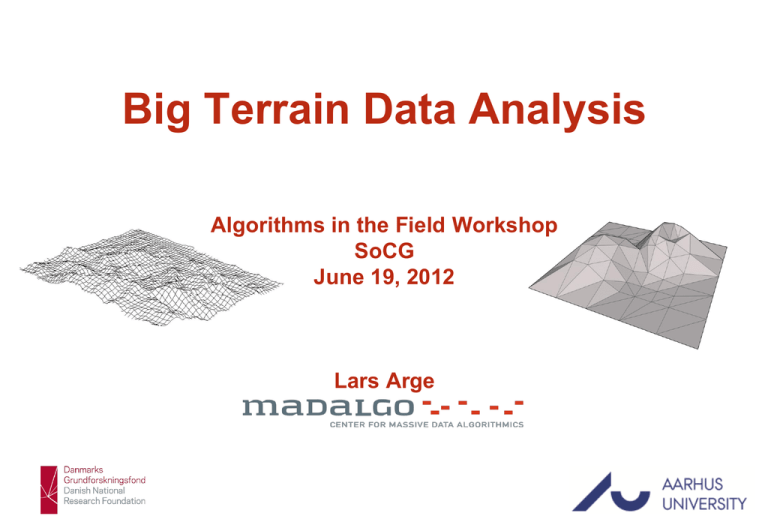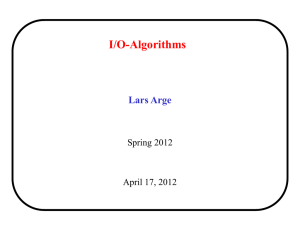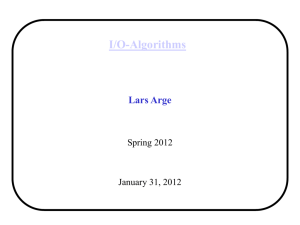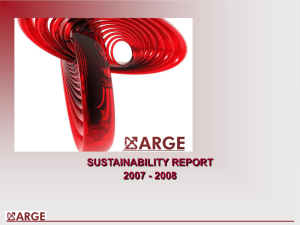slides
advertisement

Big Terrain Data Analysis Algorithms in the Field Workshop SoCG June 19, 2012 Lars Arge Lars Arge 1/43 Outline of Talk 1. Big terrain data 2. I/O-efficient algorithms 3. I/O-efficient big terrain data algorithms Surface water flow modeling 4. SCALGO Lars Arge 2/43 Big Terrain Data Lars Arge 3/43 Big Terrain Data Shuttle Radar Topography Mission (SRTM): 11 day mission in 2000 Interferometric Synthetic Aperture Radar (IFSAR) Near global dataset (60○N - 53○S) 3-arc seconds (90-meter at equator) raster ~60 billion cells in roughly 14.000 files (tiles) Lars Arge 4/43 Big and Detailed Terrain Data LiDAR delivers detailed and accurate data Denmark (~42.000 km2): Previously: Typically 30 meter resolution ~46 million points (<1GB) Now: LiDAR data of 1,6 meter resolution ~26 billion points (>1TB) NC ~136.000 km2 US ~ 9.600.000 km2 Lars Arge 5/43 Detailed Terrain Data Essential Sea-level rise (2 meter effect on Mandø) 1,6 meter terrain model 90 meter terrain model Lars Arge 6/43 Detailed Terrain Data Essential Drainage network (flow accumulation) 90 meter terrain model 1,6 meter terrain model Lars Arge 7/43 Massive Terrain Data Hard to Handle Most commercial systems cannot handle truly massive datasets and certainly not all of Denmark at 1,6-meter resolution Typical workarounds Tiling: Break terrain into pieces processed individually Not really possible for flow computations Leads to cumbersome workflows Simplification: Reduce data size Leads to unreliable results Lars Arge 8/43 I/O-Efficient Algorithms Lars Arge 9/43 I/O-Efficient Algorithms running time I/O is often bottleneck when handling massive datasets Disk access is 106 times slower than main memory access! read/write head Normal algorithm read/write arm track I/O-efficient algorithm Main memory size magnetic surface data size Disk tryintospeed amortize largemodern access time transferring “Thesystems difference between CPU and disk large contiguous of data technologies is blocks analogous to the difference in speed in sharpening a pencil using a sharpener on one’s desk or by taking an airplane to the other side of the world and blocks! using a I/O-efficient algorithms: Store and access data to use sharpener on someone else’s desk.” (D. Comer) Lars Arge 10/43 I/O-model of Computation D Model parameters [AV88] N= # of items in the problem instance B = # of items per disk block M = # of items that fit in main memory Block I/O B M Goal: Minimize I/O Move of B consecutive elements between memory and disk P Lars Arge 11/43 I/O-Efficient Algorithms Matter Example: Traversing linked list (List ranking) Array size N = 10 elements Disk block size B = 2 elements Main memory size M = 4 elements (2 blocks) 1 5 2 6 3 8 9 4 7 10 1 2 10 9 5 Algorithm 1: N=10 I/Os 6 3 4 8 7 Algorithm 2: N/B=5 I/Os Difference between N and N/B large since block size is large Example: N = 256 x 106, B = 8000 , 1ms disk access time N I/Os take 256 x 103 sec = 4266 min = 71 hr N/B I/Os take 256/8 sec = 32 sec Lars Arge 12/43 I/O-model of Computation D Block I/O Scanning: O(N/B) N N Sorting: O(Sort(N))= O( B log M B ) B Searching: O(logB N) Note: Not sort optimally with search tree B Priority queue: O(Sort(N)/N) amortized M P Many O(Sort(N)) computational geometry results Many graph algorithms results Surveys [A02,V06] Lars Arge 13/43 External Plane Sweeping Plane sweeping powerful technique for solving geometric problems Example: Orthogonal line segment intersection Sweep line top-down while maintaining search tree T on vertical segments crossing sweep line (by x-coordinates) Top endpoint of vertical segment: Insert in T Bottom endpoint of vertical segment: Delete from T Horizontal segment: Perform range query with x-interval on T Lars Arge 14/43 External Plane Sweeping Plane sweeping powerful technique for solving geometric problems Example: Orthogonal line segment intersection In internal memory algorithm runs in optimal O(N log N+T) time In external memory algorithm performs badly (>N I/Os) if |T|>M Even if we implements T as B-tree O(N logB N+T/B) I/Os Lars Arge 15/43 Distribution Sweeping Divide plane into M/B slabs with N/(M/B) endpoints each Sweep plane top-down while reporting intersections between Vertical and part of horizontal segments spanning slab(s) Distribute data to M/B slabs Vertical and non-spanning parts of horizontal segments Recurse in each slab Lars Arge 16/43 Distribution Sweeping N T I/Os Sweep performed in O(N/B+T’/B) I/Os O( N log ) M B B B B Maintain active list of vertical segments for each slab (<B in MM) Top endpoint of vertical segment: Insert in active list Horizontal segment: Scan through all relevant active lists Removing “expired” vertical segments Reporting intersections with “non-expired” vertical segments Lars Arge 17/43 (Some) I/O-Efficient Big Terrain Data Algorithms Lars Arge 18/43 I/O-model Terrain Results Model construction O(Sort(N)) Triangular irregular network (TIN): Build planar triangulation on input points and lift to 3d Delaunay triangulation [GTVV93] Constrained Delaunay triangulation [AAY05] O(Sort(N)) Raster (Grid): By Delaunay or spline interpolation [AAD06] Point data cleaning O(Sort(N)) removal of noise (outliers) in sonar data Planar graph (Delaunay) connected components Under some realistic assumptions Lars Arge 19/43 I/O-model Terrain Results Contours from model (TIN/Raster) Easy to construct contour segments in O(N/B+T/B) Hard to order segments along individual contours Tracing contours O(T) I/Os Sorting/List ranking contours O(Sort(T)) O(Sort(N)+T/B)) ordered contour map and nesting info [AAMS08] Order TIN triangles such that partial connected contours are nested like balanced parenthesis Lars Arge 20/43 I/O-model Terrain Results Model Simplification LiDAR many “insignificant” depressions e.g. ugly contours Removal of insignificant depressions: Score each depression (persistent homology) Remove low score depressions by “flooding” Insignificant Significant Sweep terrain: Depression Score = death – birth time Minimum: Component is born Saddle: Components merge; later birth time component die O(Sort(N)) simplification (persistent homology) [AAY06] Using batched Union-Find solved using distribution sweeping Lars Arge 21/43 I/O-model Terrain Results Contour simplification Removal of insignificant depressions removes insignificant contours But simplification of individual curves still needed Simplifying individual contours (e.g. Douglass-Peucker) may result in nonhomotopic and intersecting contours Recently, O(Sort(T)) practical algorithm maintaining homotopy and guaranteeing non-intersecting contours [ADMRT12] Under some realistic assumptions Simplify model directly? Open to do so I/O-efficiently! Lars Arge 22/43 Flood Modeling Lars Arge 23/43 Flood Risk Analysis Important Increasingly important to predict areas susceptible to floods Due to e.g extreme rain or rising sea-level Hurricane Floyd Sep. 15, 1999 7 am 3pm Lars Arge 24/43 Basic Raster Terrain Flow Modeling Rising sea-level: Sea-level mapping The minimal sea-level height each cell is flooded Extreme rain: Surface water flow Flow direction: The direction water flows at each cell Flow accumulation: Amount of water flowing through each cell Flow accumulation of cell = size of “upstream area” Drainage network = cells with high flow accumulation Lars Arge 25/43 Detailed Terrain Data Essential Sea-level rise (2 meter effect on Mandø) 1,6 meter terrain model 90 meter terrain model Lars Arge 26/43 Detailed Terrain Data Essential Drainage network (flow accumulation) 90 meter terrain model 1,6 meter terrain model Lars Arge 27/43 Rising Sea-Level The minimal sea-level height each cell is flooded New grid where terrain below h is flooded when water rise to h No commercial software seemed to be able to process all of Denmark at 1,6-meter resolution I/O-efficient algorithm: Result is simply simplification with score threshold ∞ [AKY06] Denmark in a day on standard 4GB desktop! Lars Arge 28/43 Flow Accumulation Initially one unit of water in each grid cell Water (initial and received) distributed from each cell to lowest lower neighbor cell (if existing) Flow accumulation of cell is total flow through it Lars Arge 29/43 Flow Accumulation Algorithm Sweep cells in decreasing height order. At each cell: Flow from flow grid and neighbor heights from height grid Update flow (flow grid) for downslope neighbors Problem: Cells of same height distributed over the terrain Scattered access to flow grid and height grid Ω(N) I/Os Natural to try “tiling”: But different tiles not independent! Performance of commercial systems are often unpredictable And cannot handle Denmark at 1,6-meter resolution Lars Arge 30/43 I/O-Efficient Flow Accumulation Eliminating height grid scattered accesses: Augment each cell with height of 8 neighbors Eliminating flow grid scattered accesses: Note: Flow to neighbor only needed when reaching its elevation Distribute flow by inserting element in priority queue Priority equal to neighbor’s height (and grid position) Flow of cell obtained using DeleteMin operations Turns O(N) grid accesses into O(N) priority queue operations O(Sort(N)) algorithm [ACHTUVW03] Denmark 1,6-meter model in two days on standard 4GB desktop! Really “Time-forward processing” technique [CGGTVV95] Lars Arge 31/43 Flash Flood Mapping Models how surface water gathers in depressions as it rains Water from watershed of depression gathers in the depression Depressions fill, leading to (potentially dramatic) increase in neighbor depression watershed size Watershed area Watershed area Volume Volume Flash Flood Mapping: Amount of rain before any given raster cell is below water Lars Arge 32/43 Flash Flood Mapping Relatively easily solved in O(N log N) internal memory time [LS05] Using priority queue and Union-Find structure Algorithm runs in O(N 𝛼(N))+Sort(N)) I/Os since no I/O-efficient online union-find structure known Recently solved in O(Sort(N) log (N/M)) I/Os [ARZ10] e.g. using time-forward processing and batched Union-Find Watershed area Volume Lars Arge 33/43 SCALGO Lars Arge 34/43 SCALGO Established in 2009 to commercialize I/O-efficient terrain processing technology Founders: Lars Arge Pankaj Agarwal Morten Revsbæk Thomas Mølhave Lars Arge 35/43 SCALGO Products Embedded SCALGO I/O-Efficient Technology Software Packages Computation Services • SCALGO S-CAN • SCALGO Model • SCALGO Hydrology • SCALGO Simplify • SCALGO Flash Flood Mapping • SCALGO Contour Maps Lars Arge 36/43 SCALGO Software Products Embedded software: SCALGO S-CAN for terrain (sonar) data cleaning within EIVA NaviModel product Software packages: SCALGO Model constructs and simplifies massive terrain models SCALGO Hydrology performs basic hydrological analysis on massive raster terrain models SCALGO Simplify adds massive raster terrain model simplification functionality to SCALGO Hydrology Lars Arge 37/43 SCALGO Model Success Stories LiDAR scan of Denmark (42.000 km2) Whole country 26 billion points in roughly 14,000 files On standard workstation with 4GB memory National 2-meter 26 billon cell raster model in 2 days Without thinning or tiling Simplification of 26 billon cell raster model full model in ½ day Lars Arge 38/43 SCALGO Hydrology Success Stories Sea-level rise: National sea-level rise tool launched on Danish Ministry of the Environment climate change portal (klimaportalen.dk) One weekend hits = normal 6 months Flow accumulation: Shuttle Radar Topography Mission (SRTM): 90-meter near global grid (~60G cells) Large USGS Hydrosheds project produced “hydrological conditioned” grid But upscaled to 500-meter to compute flow accumulation SCALGO flow accumulation in 1½ day on standard workstation Lars Arge 39/43 SCALGO Computation Services SCALGO performs computation consulting work: On big terrains using SCALGO Model and SCALGO Hydrology Using advanced in-house tool, such as tools for Production of realistic contours Flash Flood Mapping Lars Arge 40/43 Flash Flood Mapping Success Stories The major European (Danish) engineering consulting company COWI has launched product in Denmark (”Skybrudskort®“) Sold to over 10 local government and one of 5 regions (13.000 km²) Now being produced for entire country The major Florida engineering consulting company Jones Edmunds recently compared Flash Flood Mapping to result of advanced dynamic model (ICPR) for Marion County, Florida Results very close Significantly more detailed Cost under 5% (significantly reduced production time) Lars Arge 41/43 Demo Demo Sea-level rise, flow accumulation and Flash Flood Mapping Computed I/O-efficient using SCALGO Software On 1,6-meter resolution Denmark raster (~26 Billion cells) Build from LiDAR 26 Billion LiDAR points in its entirety On 90-meter resolution near global raster (~60 Billion cells) Lars Arge 42/43 Summary/Conclusion Big terrain data available, essential and hard to handle I/O often bottleneck when handling big terrain data I/O-efficient algorithms Many terrain data algorithms developed based on CG technology solutions to important practical problems Technology commercialized by SCALGO Open problem examples: Model simplification Dynamic flow models Incorporation of further data (soil type, ground water, infrastructure, …) in flow models Lars Arge 43/43









